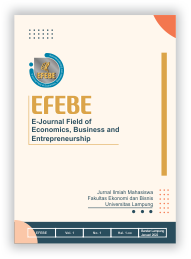Identification of the Combination of Factors Decreasing Stunting in Indonesia, using the QCA method
Identifikasi Kombinasi Faktor Penurunan Stunting di Indonesia, menggunkan metode QCA
DOI:
https://doi.org/10.23960/efebe.v3i3.282Keywords:
Stunting, Government Intervention, QCAAbstract
Stunting remains a critical challenge in improving human capital development in Indonesia. Despite numerous government intervention programs, their effectiveness in reducing stunting prevalence has not been comprehensively evaluated. This study aims to assess the effectiveness of government interventions in addressing stunting using the multi-value Qualitative Comparative Analysis (mvQCA) method, based on data from 34 provinces in Indonesia. The variables analyzed include complete basic immunization coverage, exclusive breastfeeding, National Health Insurance (JKN) ownership, access to proper sanitation, active community health posts (Posyandu), average years of schooling for women, and poverty levels. The results reveal that no single factor is consistently sufficient to reduce stunting rates. Instead, combinations of these factors form effective configurations in lowering stunting prevalence. These findings highlight the importance of adopting a holistic and contextual policy approach in tackling stunting across different regions. This study provides valuable policy implications for designing more targeted and effective interventions to combat stunting in Indonesia.
Keywords: stunting, government intervention, mvQCA, health policy, sanitation, exclusive breastfeeding, immunization, health insurance.
Downloads
Published
How to Cite
Issue
Section
License
Copyright (c) 2025 Endang Mega Utami Mega, Deddy Yuliawan, Vitriyani Tri Purwaningsih

This work is licensed under a Creative Commons Attribution-ShareAlike 4.0 International License.
E-journal Field of Economics, Business and Entrepreneurship is licensed under a Creative Commons Attribution-ShareAlike 4.0 International License Copyright Notice.









